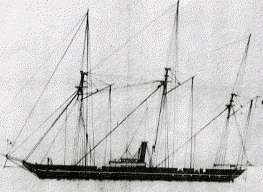Japanese warship Banryū
 | |
| History | |
|---|---|
| Name: | Banryū |
| Ordered: | 1856 |
| Builder: | R & H Green of Blackwall |
| Laid down: | 1856 |
| Launched: | 1856 |
| Commissioned: | 1857 |
| Decommissioned: | 1888 |
| Fate: | Broken up late 1890's |
| General characteristics | |
| Displacement: | 370 long tons (376 t) |
| Length: | 41.8 m (137 ft 2 in) |
| Beam: | 5.45 m (17 ft 11 in) |
| Draught: | 3.23 m (10 ft 7 in) |
| Propulsion: | Steam engine |
| Sail plan: | Schooner |
| Armament: | 6 × 12-pounder cannon |
The Japanese warship Banryū (蟠龍) was a ship of the Bakufu Navy, and subsequently belonged to the troops loyal to the Shogun during the Boshin War in Japan in 1868. Banryū was originally built in England as a schooner, where she had been named Emperor. She had a length of 41.8 metres, a breadth of 5.45 metres, a draught of 3.23 metres, and weighed 370 tons. She was armed with four 12-pounder bronze cannons.
As the HMY 'Emperor' an armed iron screw yacht, with an iron paddle ; she was presented to the Emperor of Japan at Yeddo, on the 26 August 1858.[1]
Banryū participated in the Naval Battle of Awa, Japan's first engagement between two modern fleets, on January 28, 1868.
She was also dispatched to participate to the Naval Battle of Miyako Bay in March 1869, but had to return to Hokkaido after being damaged in bad weather.
During the Naval Battle of Hakodate Bay in May 1869, Banryū managed to sink one of the Imperial navy's warships, the Chōyō. She sank in turn slightly later due to heavy damage.
She was salvaged, and renamed the SS Emperor, and returned to Japan 1873 as the Raiden Maru. Transferred to the Imperial Japanese Navy 1877 as the Raiden, serving till 1888.
She was sold in 1888 for conversion into a whaler, and was broken up at Osaka circa 1899.[2][3]

References
- ↑ Yacht presented to the Emperor on 26 August 1858
- ↑ Story of this ship
- ↑ More on the ship
- Eugène Collache, Une aventure au Japon, in "Le Tour du Monde" No.77, 1874.